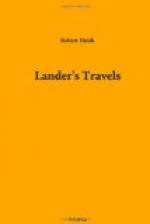The king’s house or palace, which is built of clay and grass, not whitewashed, consists of eight or ten small rooms on the ground floor, and is surrounded by a wall of the same materials, against part of which the house is built. The space within the wall is about half an acre. Whenever a trader arrives, he is required to bring his merchandize into this space, for the inspection of the king, for the purpose of duties being charged upon it. The king’s attendants, who are with him during the whole of the day, generally consist of about thirty persons, several of whom are armed with daggers, and bows and arrows. Adams did not know if the king had any family.
For a considerable time after the arrival of Adams and his companion, the people used to come in crowds to stare at them, and he afterwards understood that many persons came several days journey on purpose. The Moors remained closely confined in prison, but Adams and the Portuguese boy had permission to visit them. At the end of about six months, a company of trading Moors arrived with tobacco, who after some weeks ransomed the whole party.
Timbuctoo is situated on a level plain [*], having a river about two hundred yards from the town, on the south-east side, named La Mar Zarah. The town appeared to Adams to cover as much ground as Lisbon. He was unable to give any account of number of its inhabitants, estimated by Caillie to amount to 10,000 or 12,000. The houses are not built in streets, nor with any regularity, its population therefore, compared with that of European towns, is by no means in proportion to its size. It has no wall nor any thing resembling fortification. The houses are square, built of sticks, clay, and grass, with flat roofs of the same materials. The rooms are all on the ground-floor, and are without any of furniture, except earthen jars, wooden bowls, and mats made grass, upon which the people sleep. He did not observe a houses, or any other buildings, constructed of stone. The palace of the king he described as having walls of clay, or clay and sand, rammed into a wooden case or frame, and placed in layers, one above another, until they attained the height required, the roof being composed of poles or rafters laid horizontally, and covered with a cement or plaster, made of clay or sand.
[Footnote: This account of Timbuctoo, as given by Adams, by no means corresponds with that which was subsequently given by Caillie. The latter makes it situated on a very elevated site, in the vicinity of mountains; in fact the whole account of that celebrated city, as given by Caillie, is very defective.]
The river La Mar Zarah is about three quarters of a mile wide at Timbuctoo, and appeared in this place to have but little current, flowing to the south-west. About two miles from the town to the southward, it runs between two high mountains, apparently as high as the mountains which Adams saw in Barbary; here the river is about half a mile wide. The water of La Mar Zarah is rather brackish, but is commonly drunk by the natives, there not being, according to the report of Adams, any wells at Timbuctoo.




